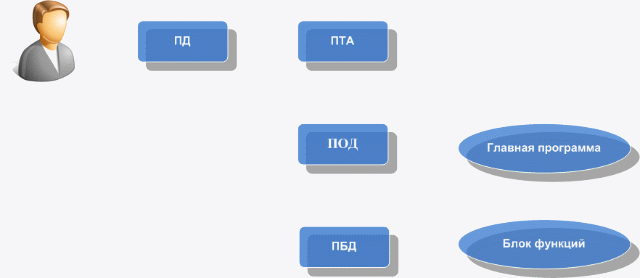Abstract of master's work
Communication subsystem in a distributed parallel simulation environment
Introduction
Urgency
Complex dynamic systems (CDS) are technological objects which parameters are intentionally changed over time. It can be described mathematically by a system of ordinary differential equations and nonlinear algebraic equations.
In modern engineering applications often comes the need for rapid modeling of complex dynamic systems. However, this task is one of the most resourceful. In many scientific and technological domains the simulation speedup along with moderate hardware costs is very important. This can be achieved by using multiprocessor computers with parallel data processing technologies. In this case the main problem of the parallel simulation is the development and construction of distributed parallel simulation environment (DPSE).
Design goals
The purpose of this master's work is the research and development of communication subsystem in a distributed parallel simulation environment.
To implement this subsystem it is necessary to accomplish the following tasks:
- Analyze researches carried out in the domain of parallel distributed simulation environments (PDSE).
- Define and identify the functions of communication subsystem of PDSE.
- Develop mathematical model and hardware structure along with software for communication subsystem.
- Design optimal data structures for CS
- Identify the principles of interaction with other subsystems and functioning as the part of the PDSE.
- Investigate the dependence of the information processes for transmission depending on the requirements, experimentally verify the results and perfomance of communication subsystem developed in the PDSE.
Scientific novelty
- Enhanced communication subsystem for better perfomance in PDES.
- Designing of CS as an independent software module in the PDES to ensure interaction with other subsystems.
- New mathematical models and algorithms for determining the parameters of the information exchange between the components of the PDES and within it's components.
- Increasing efficiency of the algorithms for data exchange in the PDES.
- Modified data structures specificaly designed to handle data transfers within PDES.
- Fully compatibile subsystem for communication with other PDES subsystems.
Practical value of work
The development of CS in PDES achieves very important goal - finds optimal routes to minimize information transfer time between components in the PDES.
Communication subsystem is a centralized structure, which is responsible for ensuring the exchange of data between components of the PDES. One of the main requirements for this system are high speed and accurate synchronization of the exchange.
CS will consist of a main program that interfaces with other subsystems and internal routines that are responsible for a certain number of tasks. When a call to a subsystem occures - the main program takes the call, and then transferrs control to the desired subroutine. Upon completion of the subroutine main program receives and analyzes the results giving them out. The interaction of CS with other subsystems is shown in Figure 1.

Figure 1 - Interaction with other subsystems in PDES
Animation: Size - 17.3 kb, resolution - 640x278, the number of frames - 13, repeat cycles - 6.
Choosing a software platform for the implementation of CS has the following requirements:
- high speed of the code;
- simplicity and reliability;
- modularity;
- advanced tools.
Conclusion
Communication subsystem as the complete centralized subsystem of the distributed parallel simulation environment is a challenging problem for further research and development. This master's thesis defines the main functions, structure and workflow of the algorithms. It provides opportunities for further development for another individual and the PDES as a whole. This work has practical value for further research and development related to the PDES.
Literature
- Абрамов Ф.А., Фельдман Л.П., Святный В.А. Моделирование динамических процессов рудничное Аэрология.- К.: Наук. Мысль, 1981.-284с.
- Святный В.А. Моделирование аэрогазодинамических процессов и разработка систем управления проветривание систем шахт. Докт. дисс, Донецк, ДПИ, 1986
- Мирошниченко К.В. Разработка и исследование подсистемы топологического анализа сетевых динамических систем как объектов моделирования [Электронный ресурс] / Портал магистров ДонНТУ, 2011 - http://masters.donntu.ru/2011/fknt/myroshnychenko/diss/index.htm
- Schmidt B. Simulationssyteme der 5. Generation – SiP, Heft 1, 1994, S. 5–6.
- Anoprienko A.J., Svjatnyj V.A., Braunl T., Reuter A., Zeitz M.: Massiv parallele Simulationsumgebung fur dynamische Systeme mit konzentrierten und verteilten Parametern. 9. Symposium ASIM’94, Tagungsband, Vieweg, 1994, S. 183-188.
- Святний В.А. Паралельне моделювання складних динамічних систем // Моделирование – 2006: Международная конференция. Киев, 2006г. – Киев, 2006. – С. 83–90.
- L. P. Feldmann, V. A. Svjatnyj (FRTI DonNTU, Ukraine); M. Resch, M. Zeitz (Universitat Stuttgart, Deutschland) Forschungsgebiet: parallele Simulationstechnik [Электронный ресурс] / Национальная библиотека Украины имени В.И. Вернадского, - http://www.nbuv.gov.ua/portal/natural/Npdntu/Pm/2008/08flpfps.pdf
- Svjatnyj V., Moldovanova O., Smagin A., Resch M., Keller R.: Rabenseifner R. Virtuelle Simulationsmodelle und ein Devirtualisierungsvorgang fur die Entwicklung der parallelen Simulatoren von komplexen dynamischen Systemen / 9. Symposium ASIM 2006, Tagungsband, 2006, S. 416 - 421.
- Хамылов А.А. Разработка и исследование подсистемы виртуальных параллельных моделей РПМС [Электронный ресурс] / Портал магистров ДонНТУ, 2011 - http://masters.donntu.ru/2011/fknt/khamylov/diss/index.htm
- Кушнаренко В.Г. Разработка и исследование подсистемы параллельных решателей уравнений распределенной параллельной моделирующей среды (РПМС) [Электронный ресурс] / Портал магистров ДонНТУ, 2011 - http://masters.donntu.ru/2011/fknt/kushnarenko/diss/index.htm
Note:
The master's work is not yet complete. Finally, completion: December 2012. The full text of the work and materials on the topic can be obtained from the author or his head after that date.
